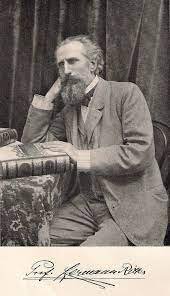Hermann Ritter was a rather remarkable violist, composer, and musicologist. Ritter started out as a violinist, switched his focus to the viola and the nascent field of musicology, and made it his mission to raise the standard of viola performance and make the instrument “tonally equal” to the violin and cello (the problem being that if the viola had the acoustically appropriate proportions for its range it would be too small to play like a cello and too big to play like a violin). Ritter’s solution was simply to make bigger violas and find bigger violists to play them.
As the story goes, in February 1876, half a year before the premier of the Ring cycle, Ritter presented his Viola Alta to Wagner, performing “Lied an den Abendstern,” an aria (Wagner did write such things in his youth) from Tannhäuser. Wagner was impressed, exclaiming, “Das richtige alt instrument!” Ritter was immediately hired as the first Solo Violist of the Bayreuth Festspielorchester and the hands of the viola section were filled with Viola Altas. It is fitting that the premiere of the Ring, which benefited from a bigger opera house, a bigger orchestra, a Wagner tuba, a Wagner bell, a Stierhorn (an actual steer horn), anvils, a bass trumpet, a contrabass trombone, and six harps, also had bigger violas. And it is furthermore fitting that the human carnage Wagner left in his wake should include dozens of violists who had to play his five-hour long operas on eighteen-to-nineteen-inch Viola Altas.
A surprisingly large and largely unknown body of solo music was written or transcribed for the Viola Alta, with Ritter’s twenty-one original compositions and fifty-nine transcriptions for the Viola Alta (as well as thirty musicological prose publications) leading the way. Ritter’s music is schlocky, delightful, and good enough often enough to make it worth exploring. Curiously, like the music of many of Wagner’s disciples, it doesn’t sound very much like Wagner - more like the 19th-century Grand opera style that Wagner vehemently reacted against.
All of these characteristics hold true for Ritter’s Concert-Phantasie No.1, Opus 35 (1886), written expressly for the Viola Alta, although recorded by us with the regular viola for health reasons. Here we present Ritter’s Concert-Phantasie in an abridged version. In full it is in three movements and comes close to twenty minutes, which is ponderously long for the material and its repetitive nature. In our abridged version we combined the first movement with the coda of the 3rd movement to create a compact sonata-rondo-like structure that works well as a recital crowd-pleaser.
Something must be said here about the recording process and Take 100. We recorded two run-throughs of the Ritter at the end of the second day of recording, which was the nadir of our energy and morale. Our strategy was to get those run-throughs down, listen back for spots that weren't sufficiently covered between those two takes, and do a sweep through the next day. Take 100 was the second of those takes. The first few minutes sounded like we were at the nadir of our energy and morale - and then I went berserk. What followed was chaotic, exciting, and rough. Listening back we were taken by the spontaneity and energy of Take 100. Although it does not have the cleanliness and accuracy one normally expects on a recording, it just sounds better and is more in the spirit of the piece. We hope you enjoy what we have dubbed “Ritter 100 PROOF,” and feel transported along with us to that dispirited, dreary late afternoon when inspiration unexpectedly struck.
Daniel Orsen
January 2023

